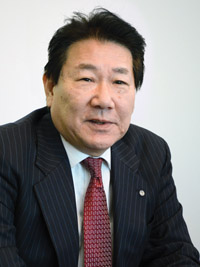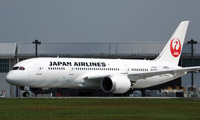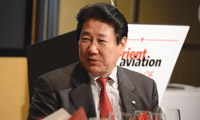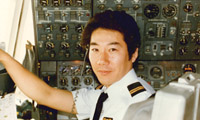Cover Story
BREAKING FREE
When Kazuo Inamori, the venerated businessman who led Japan Airline’s recovery from bankruptcy, handpicked one of the airline’s captains as the airline’s new president, corporate tradition was turned on its ear. But Yoshiharu Ueki (61), the 2013 Orient Aviation Person of the Year, has made the transition from cockpit to boardroom with ease.
December 1st 2013
It’s been a momentous two years for Japan Airlines (JAL) president, Yoshiharu Ueki, the pilot turned boss who stepped into the mighty shoes of octogenarian Kazuo Inamori, the legendary Japanese business tycoon who led JAL out of its 2010 bankruptcy. Read More »
 |
| Yoshiharu Ueki President Japan Airlines |
So far, Ueki’s score sheet has been impressive. He took delivery of the first JAL B787 ‘Dreamliner’ in March 2012, two months after becoming the airline’s president. He led the highly successful JAL re-listing on the Tokyo Stock Exchange in September last year. And most attention grabbing of all, he chose to order the A350 last October, a decision that revealed Ueki was very much his own man.
After the announcement that JAL would buy 31 A350s with 25 options, there was much media speculation about Ueki’s choice. JAL had long been considered a ‘Boeing only’ customer so the decision to buy from Toulouse instead of Seattle suggested, to some observers, that the reported opinion of Inamori, now JAL’s chairman emeritus, had been followed to avoid one supplier dependency.
Buy what is best was the only advice he got from Mr. Inamori on this issue, Ueki said when he spoke to Orient Aviation in November. “Taking into consideration all the factors – timing, economics and stage of development – we chose Airbus.”
In the hugely complex world of airline operations there are few airline bosses who are former pilots and JAL is no exception. Ueki is JAL’s first captain turned president. He was still flying until four years ago, when Inamori, Kyocera founder, philanthropist and Buddhist monk appointed by the government to revive JAL’s fortunes, set his eyes on him.
In April 2010, he chose Ueki to revise JAL’s over-extended and unprofitable route network. As head of the route planning section, Ueki impressed his peers with the introduction of Inamori’s profit-focused action formula. He axed 45 unprofitable routes, a decision that quickly improved revenue. In 2011, Inamori promoted Ueki to executive officer, a stepping stone to his elevation to president in 2012. He succeeded Masaru Onishi, who became JAL chairman.
“Using Inamori’s methods, which emphasized profits and speedy analysis of financial performance, I broke free from my own fixed ideas,” Ueki told Orient Aviation at JAL headquarters in Tennozu, where Haneda Airport is visible across Tokyo Bay.
At the time, Inamori praised Ueki for his upbeat personality. Lack of corporate experience didn’t count for much with the management guru, who expressed his confidence in Ueki’s ability to read a balance sheet and ‘steer the operations’ when he announced Ueki’s presidency almost two years ago.
Ueki admits that his debt to Inamori is immense.
 |
| 'The B787 is a very innovative airplane, so early stage failures are seen from time to time' |
| Yoshiharu Ueki |
During the period from 2010 to 2012, when the Corporate Rehabilitation Law was applied, JAL was obliged to make crucial decisions every day and Inamori was a good teacher, leading by example, Ueki said.
“I can think of a hundred examples of Inamori’s management teachings,” he said.
For example, he said, many Japanese organizations work on a budget system, allocating funds for projects. In the past, JAL followed this system and budgeted money that was meant to be spent. The conventional wisdom of such a system is, basically, if you don’t use it, you lose it.
Inamori disliked the word “budget” and used the word “plan” instead. He urged JAL staff to re-check plans before implementation, even if the budget had been allocated at the beginning of the Japanese fiscal year, which runs from April to March.
Using an illustration from the public sector, Ueki pointed out that in February and March, as the Japanese fiscal year draws to an end, unnecessary – and unplanned – road construction works start all over the place to use up budgeted money. Inamori ruled that if “the plan” is unnecessary then the money should not be spent, thereby controlling costs.
Said Ueki: “It’s important to find what is really necessary and what is not. So timely checks of the state of plans and their relevance are always necessary.”
Inamori’s teachings are incorporated in a 125-page pocket-sized book, the JAL Philosophy Handbook, which covers some 40 items and is carried by all employees.
The handbook is regarded as confidential. Copies are not supposed to leave company premises and only are for use by JAL employees. One exception was made when Inamori gave a copy to American Airlines’ former CEO, Gerard J. Arpey, who was a good friend and had expressed interest in the little volume of wisdom.
 |
| 2013 Orient Aviation Person of the Year, JAL president, Yoshiharu Ueki |
Ueki showed one important chapter, entitled ‘The Equation of Success of Life’, to Orient Aviation, who asked for a photocopy.
An aide pointed out JAL rules did not permit external distribution of the handbook’s contents. Ueki overruled the aide. “I’m the president,” he said with a laugh. “It’s O.K.” The visitor got his photocopy.
Ueki’s communication skills are well-regarded. He has started to use social media to reach out and contact both employees and customers.
His first posting on LinkedIn reads: “I joined Japan Airlines as a pilot and spent 35 years flying various types of aircraft, from 50-seat commuter planes to 500-seat jumbo jets. Today, I manage a group of companies and represent more than 30,000 employees in my role as President of Japan Airlines.
“My years of experience, both in the air and on the ground, have taught me about the importance of responsibility. I’ve come to realize it makes no difference whether you are piloting an aircraft or you are leading a company.
“Passenger aircraft captains are solely responsible for the safe transportation of travelers and crew from the moment they step onboard to block-in at the destination. It’s easy to say that pilots should ensure the safety of all the precious lives they carry, but in actuality, they constantly feel the heavy weight of responsibility while assuming their duties.
“This is also true for business leaders as they are responsible not only for operating a successful business, but for ensuring the livelihood of all employees and their families. The burden of responsibility is the same, regardless of the number of people being protected.”
He confirmed those sentiments in the interview. “The basis of captain and president must be the same,” he said. “Otherwise, I should not be able to steer JAL. Of course, the knowledge required of a business executive and an airline captain is different. But decision-making is essentially the same,” he said.
 |
| 'Whether you are a pilot or a business leader, its all about the destination' |
| Yoshiharu Ueki |
“A captain has to cope with a vast range of issues such as maintenance troubles, adverse weather, sudden illness in the cabin and so on. A top manager of a company faces issues too, requiring swift and clear decisions.”
Ueki’s father was a famous movie star, Chiezo Kataoka, whose acting career spanned six decades, from his debut as a child in kabuki plays to his last films in the 1970s. He had a unique delivery, which may have rubbed off on his son, who has a great reputation for well-composed in-flight announcements.
In those days children of theatre and movie actors often used to follow their parents to screen or stage. As a young child, Ueki acted in several movies with his father, but did not follow him into show business.
“I was born in 1952 and there was a 50-year age gap between my father and me,” Ueki said. “He would be 110 years old now if he still lived. Nobody in the Ueki family followed our father’s occupation. That was very exceptional by the standards of show business families at that time. I wasn’t bound by tradition.”
“In any case,” he added, “my mother was a very strong woman and insisted that until I graduated from university I would be my parents’ responsibility. If, after college, I wanted to be an actor, so be it.”
But that scenario never arose. A 1968 visit to Sweden, in a high school home stay program, changed his life. His host family’s father was a captain at Scandinavian Airlines System (SAS). He cut a dashing figure in his smart uniform. Young Ueki was 16 years old and greatly impressed. He decided he too, wanted to be a pilot.
Fresh out of high school, Ueki initially failed the entrance exam at Japan’s Civil Aviation College. But he did land a place at prestigious Keio University in Tokyo.
Despite that the setback, his mother urged him to retake the aviation college exam. This time he passed. It was a real-life lesson in “not being allowed to back down as a loser”, he said. It’s a lesson he has never forgotten.
One of the biggest issues facing Ueki is the international day time slot allocation at Tokyo’s Haneda Airport.
Japan’s Civil Aviation Bureau, part of the Ministry of Land, Infrastructure, Transport and Tourism (MLIT), stunned JAL on October 2, when it announced the allocation of 16 slots to the two leading Japanese carriers would not be on a fifty-fifty basis. Instead, it gave 11 slots to All Nippon Airways (ANA) and five to JAL.
The announcement shocked Ueki too. JAL responded to the MLIT two days later with a request for reconsideration of the decision, citing a lack of transparency in the allocations. The ministry’s eventual response, early in November, to JAL’s request for disclosure was a blunt refusal to reconsider the slot placements.
Political interference is widely believed to be behind the decision. Members of the Liberal Democratic Party, now back in power, have been extremely vocal in criticizing JAL’s rescue by the previous Democratic Party of Japan government.
JAL critics claimed the carrier’s rehabilitation with state-backed funds had created an advantage for the airline over rival, ANA, and that some rebalancing was needed to ensure “fair competition”.
MLIT’s November reply to JAL did not include reconsideration of the decision. A ministry official called it “water under the bridge”. Once made, slot allocations have never been changed, the official said.
Said Ueki: “JAL is insisting on an equal allocation of slots, not only for the sake of the company, but for airline customers and the general position of the airline industry.
“Our mid-term plan is completed and is based on equal allocation, so if the reconsideration will not be made, it will cut our operating profit by 16 billion yen annually,” Ueki said. If nothing changes, JAL will be forced to revise next year’s summer schedule and modify medium and long-term business strategy.
“We can never agree with political interference,” said Ueki.
Ueki faces other political challenges as well in his efforts to build JAL’s business profitability. Territorial disputes with neighbors, China and South Korea, have negatively hit JAL traffic on key routes to the two nations, with Japanese passengers, always sensitive to political issues, decreasing in large numbers to the near neighbour destinations.
In the first half this year, passengers on Japan-China routes declined by 5 % year-on-year. Fortunately, passengers from China and connecting passengers from North America to China are increasing, noted Ueki.
Chinese visitors to Japan in the first half, to September 30, had slumped until September, when there was a sudden upward surge of 28.5% year-on- year, according to Japan National Tourist Organization statistics.
“I think demand will recover in the course of time so JAL will maintain the present scale on China routes,” Ueki said.
While Japanese travelers are heading elsewhere, Korean visitors to Japan have increased by 10%. Since the entry of LCCs into the market, Korean Air and Asiana Airlines have started to reduce air fares, making Korean routes an expanding, but fiercely competitive market. Korean visitor growth to Japan has been constant throughout the year, although it dropped in August.
For the time being, Ueki said, JAL will maintain the present scale of operations. But when Narita-based LCC affiliate, Jetstar Japan. starts to fly to Korea, JAL will consider using the low-cost carrier to complement JAL operations. Jetstar Japan has not decided when it will expand to regional routes.
Ueki keeps a careful eye on the impact of LCCs in Japan, both domestically and internationally. Jetstar Japan’s performance, since it started flights in summer 2012, was worse than JAL had expected. Difficulties with its Narita base, bad weather and maintenance issues have dogged the new airline. Expressing confidence that it will succeed, JAL and partner, Qantas, each injected 5.5 billion yen into the LCC on October 31.
According to Ueki, Jetstar Japan needs to work on its business model to better fit the “unique market of Japan”. Recently, the carrier signed a distribution deal with the Lawson chain of convenience stores that is expected to give sales a major boost.
From now on, JAL will fully assist and discuss with Jetstar Japan plans to make the carrier profitable, Ueki said.
“I am confident that the LCC will be profitable in future. That’s why JAL agreed on the extra capital infusion,” he said of the joint venture.
JAL is a major operator of the B787 ‘Dreamliner’. The four and half month grounding of the aircraft, following battery combustion incidents caused problems.
“The B787 is a very innovative airplane, so early-stage small failures are seen from time to time,” Ueki said. “Those have been worrying,” he acknowledged, but after the checks and modifications were done, he felt things were improving.
The grounding of the B787 fleet was not a factor in the decision to order the A350, he added.
JAL’s next fleet renewal decision will be about single aisle aircraft, mainly for domestic use. For example, Okinawa-based affiliate, Japan Transocean Air (JTA), has 12 737-400s earmarked for replacement. JAL will study both Boeing and Airbus proposals.
Ueki doesn’t think JAL is likely to consider the A380 for the near future as JAL fleet policy is more fixed on smaller capacity aircraft for long-haul operations, such as the B787 and the A350.
With almost two years as president behind him, Ueki is now looking into the future. “The past three years were spent forming a stable foundation for the revitalized company,” he said. His task in the next three years is to make JAL an attractive airline for customers and employees alike.
“If employees believe in a bright future for JAL, customers will also sense it and it will give them confidence [in us],” he said.
“We are formulating investment plans – for hardware and software – and these are almost finalized. But to be successful, the willing spirit of the employees is of paramount importance.
“We have to break away from fixed ideas and follow what is probably Inamori’s most important philosophy, which is that the outcome of life and work is the product of three factors: attitude, efforts and ability.
“JAL people used to focus on effort and ability, but in Inamori’s equation, the right attitude counts the most. It’s my job to create the corporate environment to ensure that.
“Whether you’re a pilot or a business leader, it’s all about the destination.”